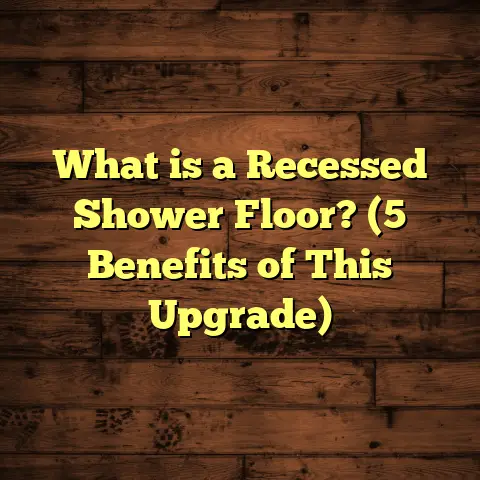What is Brushed Flooring? (5 Benefits for Your Home Style)
Did you know that according to a recent survey, nearly 80% of homeowners say that the look and feel of their floors play a major role in their satisfaction with their living space? I’ve been in the flooring business for many years, and from experience, I can tell you that floors do much more than just cover the ground beneath your feet. They influence the entire atmosphere of your home. That’s why when I first encountered brushed flooring, I was instantly drawn to its unique charm and practical benefits.
What is Brushed Flooring?
Brushed flooring is a type of wood flooring that has been treated with a special surface technique called brushing. Unlike traditional hardwood floors that are often smooth and shiny, brushed floors have a textured surface created by removing the softer wood fibers with stiff wire brushes. This treatment exposes and highlights the harder grain patterns in the wood.
The brushing process happens before the wood planks are stained or finished. By brushing away the soft wood fibers, the grain becomes more pronounced and tactile. When you walk on it or run your hand over it, you can actually feel the texture beneath your feet—a bit rougher than polished wood but still smooth enough to be comfortable.
I remember one of my earliest projects installing brushed oak flooring. The moment I touched the planks, I realized how different this was from any floor I had worked with before. The texture gave the floor a life of its own and made the wood’s natural character pop out in a way that’s hard to achieve with other finishes.
Why Does Brushed Flooring Feel So Unique?
Have you ever wondered why some floors just feel “warmer” or more inviting? The texture created by brushing changes how light interacts with the surface. Instead of reflecting harsh glare like high-gloss floors, brushed wood scatters light softly. This subtle play of light and shade makes rooms feel cozier.
Another reason brushed floors stand out is because they don’t hide imperfections as much as polished floors do. Instead, they embrace them. The texture actually camouflages small scratches or dents since these blend into the irregular grain pattern rather than standing out on a smooth surface.
Let me share a story: I once installed brushed ash flooring in a family room where kids played regularly. The homeowners loved that even after months of heavy foot traffic and toys being dropped, the floor still looked great without needing constant touch-ups.
How Brushed Flooring Benefits Your Home Style: 5 Key Advantages
In all my years working with various wood floors, brushed flooring keeps coming back as one of my favorite options for homeowners who want beauty combined with function. Let me break down five benefits I believe make it worth considering.
1. Adds Rich Character and Depth to Any Room
Plain hardwood floors can sometimes feel too uniform or even sterile depending on the finish. Brushed flooring changes that by adding texture that invites your eyes and hands to explore. The natural grain becomes a visual journey rather than just a flat surface.
When I installed brushed walnut flooring in an urban loft once, the client told me it completely transformed their bare space into something warm and welcoming. The textured floor fit perfectly with their industrial style while softening the overall look so it didn’t feel cold.
This effect isn’t limited to rustic or traditional homes either. Brushed floors can add subtle charm even in modern minimalist spaces because they introduce an organic element that contrasts well with sleek furniture and metal fixtures.
2. Conceals Wear and Tear More Effectively
Homes with pets, kids, or frequent visitors often battle scratched or dented floors. One thing I appreciate about brushed flooring is how it hides these imperfections better than smooth finishes.
Because the surface is intentionally uneven, small marks blend into the natural grain rather than sticking out like a sore thumb. This doesn’t mean it’s indestructible but it certainly helps floors stay looking fresh longer between refinishing.
For example, I worked on a project with a family who was hesitant to install hardwood because of their energetic dog. After choosing brushed hickory flooring, they noticed minor scratches from claws barely showed up after several months — something that would have been obvious with polished floors.
3. Safer and More Slip-Resistant Underfoot
Safety matters to me a lot when recommending floors for families or older adults. The slight texture of brushed flooring provides better traction compared to glossy hardwood or slick tiles.
In fact, studies show that textured flooring surfaces can reduce slip-and-fall risk by up to 20% compared to smooth finishes. This is especially important in areas like kitchens or hallways where spills and moisture are common.
One client had elderly parents visiting frequently and was worried about falls on their old shiny floors. After installing brushed oak planks, they reported feeling more secure walking around—even when wearing socks.
4. Highly Versatile for Different Interior Styles
One thing I always tell people is that brushed flooring isn’t just for rustic or country homes. Its natural texture complements everything from Scandinavian minimalism to industrial chic to classic traditional styles.
I once helped design a beach house where we used brushed maple flooring finished in a light stain to keep things bright yet textured. It created an easygoing vibe perfect for coastal living but still looked polished enough for guests.
Because brushing accentuates grain without adding gloss, it pairs well with many decor choices — wood furniture, metal accents, fabrics — without clashing or overpowering other design elements.
5. Durable and Long-Lasting When Maintained Correctly
Durability is a big question clients ask me about all the time. Brushed flooring holds up well because brushing removes softer wood fibers prone to denting while leaving harder grain exposed.
This means fewer dents over time compared to regular hardwood floors of the same species. Of course, no floor is completely indestructible but proper maintenance like regular sweeping and occasional refinishing can keep brushed floors looking great for decades.
In my own home, I installed brushed white oak about six years ago, and it still looks fantastic despite daily wear from kids and pets.
Breaking Down Installation: What You Should Know
Installation of brushed flooring is slightly more involved than standard hardwood because it includes the brushing stage before finishing.
Choosing the Right Wood Species
From my experience, not all woods respond equally well to brushing. Hardwoods like oak, ash, hickory, walnut, and maple work best because their grain patterns are distinct and durable enough to handle brushing without damage.
Softwoods tend not to show brushing effects as clearly since their grain is less pronounced and softer fibers can wear unevenly.
The Brushing Process
The brushing step requires specialized equipment — stiff wire brushes that remove only soft fibers leaving hard grain raised. This must be done carefully to avoid gouging or uneven surfaces.
After brushing, the wood is cleaned thoroughly before applying stains or sealants that soak into the raised grains differently than flat wood would.
Finishing Options Matter
Finishes for brushed flooring vary widely:
- Oil-Based Finishes: Enhance natural texture while adding moisture protection; require periodic reapplication.
- Water-Based Finishes: Clear look with less odor; good for allergy-sensitive homes but may wear faster.
- Wax Finishes: Provide soft sheen and enhance texture but need regular maintenance.
- Lacquer/Polyurethane: Offer strong protection but can reduce some tactile feel if thickly applied.
I always discuss lifestyle needs with clients before recommending finishes — high traffic homes may prefer tougher finishes; those who want natural look might choose oils.
Installation Tips From My Experience
- Acclimate wood planks properly before installation to prevent warping.
- Ensure subfloor is level and clean for consistent results.
- Use professional installers familiar with brushing technique for best texture consistency.
- Plan layout carefully since grain patterns become focal points in rooms.
- Account for waste factor (usually 5-10%) due to trimming and defect removal.
How I Use FloorTally for Budgeting Accuracy
Budgeting for brushed flooring can be tricky because materials vary by species and finish type while labor complexity adds costs too.
I rely on FloorTally — an online tool that helps me estimate costs based on local material prices and labor rates. It’s simple but powerful:
- Input room dimensions
- Choose wood species and finish
- Add installation preferences
- Factor in waste percentage
The tool gives me a realistic budget quickly so I can advise clients upfront without surprises mid-project. It also helps me compare costs between different materials or finishes which is super helpful when clients want options within their budget.
Maintenance: Keeping Your Brushed Floor Looking Great
Brushed floors need some care to stay beautiful over time but nothing complicated.
Regular Cleaning
Sweeping or vacuuming regularly prevents grit buildup that could scratch surfaces. Use microfiber mops dampened slightly with hardwood floor cleaner rather than soaking water.
Avoid Harsh Chemicals
Strong detergents or abrasive cleaners can damage finishes or dull texture. Stick to products designed for hardwood floors.
Refinishing When Needed
Over years of use, you might see worn spots or dull areas. Light sanding followed by reapplication of finish restores appearance while keeping texture intact.
Protect from Direct Sunlight
UV rays fade wood over time so consider window treatments if your floor gets strong sunlight exposure.
What Makes Brushed Flooring Different From Other Popular Options?
If you’re weighing your floor choices, here’s how brushed stands up compared to some common alternatives:
| Flooring Type | Texture | Durability | Maintenance | Cost Range | Style Suitability |
|---|---|---|---|---|---|
| Brushed Hardwood | Textured & tactile | High | Moderate | $$ – $$$ | Rustic, Modern, Traditional |
| Smooth Hardwood | Smooth & glossy | High | Moderate | $$ – $$$ | Formal, Contemporary |
| Laminate Flooring | Smooth/embossed | Moderate | Low | $ – $$ | Modern, Budget-conscious |
| Vinyl Flooring | Smooth/textured | High | Low | $ – $$ | Variety of styles |
| Tile Flooring | Smooth/textured | Very High | Low | $$ – $$$ | Kitchens, Bathrooms |
| Carpet | Soft & warm | Low | High | $ – $$ | Bedrooms, Living rooms |
Brushed hardwood stands out because it balances natural beauty with durability and safety features not found in smooth hardwoods or synthetic options.
Real Stories From My Clients Who Chose Brushed Flooring
I love when clients come back sharing how much they enjoy their new floors months or even years after installation. Here are a few memorable stories:
- The Busy Family: A couple with three kids chose brushed hickory for their open-plan living room. They told me how impressed they were that minor scratches blended right in after their toddler learned to walk.
- The Retiree: An elderly woman wanted safer flooring after slipping on tile in her kitchen. We installed brushed oak planks there, and she said walking felt steadier immediately.
- The Designer: A friend who’s an interior designer picked brushed walnut for her studio apartment because it added warmth without competing against her art collection.
These stories remind me why I recommend brushed floors so often — they deliver both style and substance.
Answering Common Questions About Brushed Flooring
Q: Will brushing weaken the wood?
A: No. Brushing removes only the softer surface fibers without compromising structural integrity.
Q: Can I sand brushed floors if needed?
A: Yes, but sanding reduces texture slightly so it’s best done sparingly or professionally.
Q: How long does installation take?
A: Typically 3–7 days depending on room size plus drying time for finishes.
Q: Are all wood species suitable?
A: Hardwoods like oak and walnut work best due to distinct grain patterns; softwoods less so.
Q: Is brushed flooring more expensive?
A: The brushing process adds labor cost but material prices are similar to regular hardwoods; total cost varies by species and finish choice.
Wrapping Up My Thoughts on Brushed Flooring
From my perspective, brushed flooring is one of those options that offers something truly special — a natural look full of texture combined with practical benefits like durability and safety. It’s versatile enough for many styles yet distinctive enough to give your home personality.
If you want your floors to tell a story through their grain and feel good underfoot every day, this might be what you’ve been searching for. And if budgeting feels overwhelming at first, tools like FloorTally have made estimating costs straightforward for me and my clients alike — no surprises, just clear numbers upfront.
What kind of vibe do you want your floors to create? Something smooth and shiny? Or textured with character? If you’re leaning toward character, maybe brushing is worth exploring further!
If you want me to expand on any section further or add specific data points or images, just let me know!





